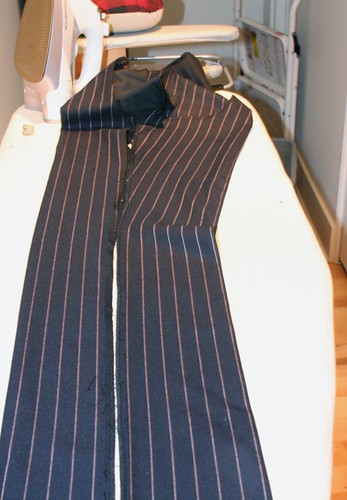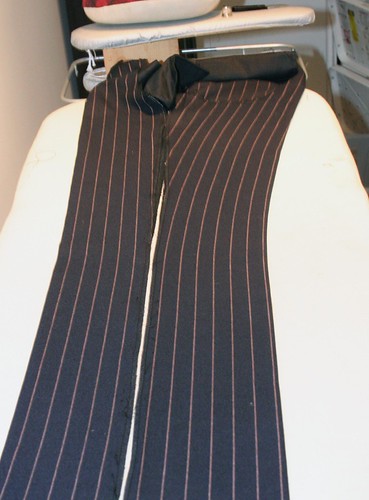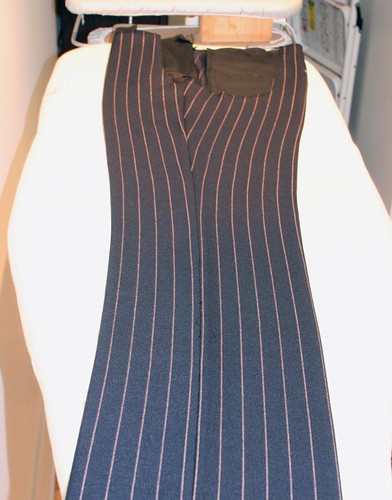We've been discussing trousers on the T&C forum & it occurred to me that I haven't really looked at trousers on my blog. Largely because I feel that there is a lot less room for individual expression and nuance in trousers than in jackets, which I, of all people, should know is not really true. I explain.
Working in the RTW industry in Canada gives me an interesting perspective in that I sell garments in Canada, the United States, and sometimes central America, Europe and Asia; regional variations in taste and fit are more obvious to me than someone who only sells into one market. But let me focus on Canada and the U.S. who share a similar history and culture but have very distinct tastes in trousers. I can sell basically the same cut of jacket into the States as I do in Canada, though generally a little easier in the U.S., but the trousers are a deal-breaker. It has always been a basic truth in our trade that (despite the fashion cutomer whose preferences bounce around quite a bit) Americans like a big, roomy, pleated, high-waisted trouser and Canadian prefer the opposite, namely a trim, plain-front, low-rise trouser. We had some leftover suits hanging in stock that had been cut for the States and no matter what kind of promotional price we might offer in order to get rid of them here, nobody wanted to touch a pleated, easy trouser so we had to cut them down to slimmer, plain front versions in order to liquidate them in Canada. A major expense (and royal pain) but we had to do it.
The British and the Neapolitans have different cultures and sartorial traditions so it is understandable that their preferences in cut should differ, but why would we find such a disparity between Canada and the U.S.? I've never really thought much about it until now.
Which brings me back to my next project. Bigger, easier trousers are more forgiving in their fit and require a bit less shaping in order to get a good fit; close-fitting trousers, like those that I cut for myself, need a bit more help. I just got a nice, sturdy piece of English cloth from which I'm going to make a suit and we'll look a bit at the shaping that goes into a traditionally-made trouser. Some of it is at construction level, but the shaping that I do in pressing can be used by anyone who is pressing their trousers at home to refine the fit a bit.
My next suit- a navy twill with a soft pink stripe.
Having typed this, I wandered over to T&C to see that Sator had posted this article on shaping the trousers. which saves me the work of having to illustrate it. I don't have much to add except that in a factory setting in order to control the amount of stretching and shrinking, we shift the knee notch up by 1/4" to 3/8" on the back panel- this has the effect of introducing fullness into the calf area and shortness in the back of the thigh. When we press the seams open and crease the trouser we then stretch the back thigh and front calf, eliminating any ripples of fullness in the seam and doing the same shaping.
The waistband should also be shaped, which is not illustrated so I will do that. To allow for that shaping, we ease some fullness on the front panels onto the waistband when sewing it on ( which is alluded to in the German text).
So here's a bit of a recap of the German text on ironwork, but with an explanation of WHY we are doing it. Note that normally I construct the fly before joining the front to the back but it would be difficult to see the result of the shaping so I am putting them together in the wrong order for the sake of this demonstration.
When the two panels are creased along their center line and placed next to each other, we see a gap at the thigh and the knee. Trousers which are narrower at the knee will have a greater gap and require more shaping than ones which are a little looser, as will trousers which are cut closer at the thigh. These are not really flared bottom trousers- the camera distortion makes it look like that.
If we shift the back panel to meet the front as if the seams were joined, we can see the excess length this creates at the back of the trouser, which often puddles around the wearer (not to be confused with a garment which has not been cut properly for forward hip posture, which will also puddle around the calves)
To make up for this extra length in the back we will use a combination of stretching the seam around the thigh and the knee, and shrinking a bit of the length out at the back. As David rightly pointed out in the T&C discussion, the trouser is subject to strain during wear so some shaping is bound to be lost- this is true of some of the shrinking so I prefer to do more stretching than shrinking. Notice the stripe line in the back panel.
The panels are then joined and the back of the calf given some additional shaping.
Here is the waistband which has been pressed into a curve to conform better to the waistline. Lower-waisted trousers need more shaping than higher-waisted ones.








11 comments:
Jeffery:
While still in the construction phase of your latest project, might you consider the options of having both brace buttons on your traditional trousers (which I assume means high-rise trousers with double forward pleats) as well as self side tabs with buckles? If the latter are to be included, there seems to be a question of just where to place them.
Is it on the either side of the waistband, or just below the waistband and above the onseam hip pockets, or is it just below the waistband and more or less above the back pockets (for those who insist on having jetted pockets on their backside, which I think ruins the line of striped woollen cloth). If an extra pocket is needed, why not use the Oxxford Clothes hidden trouser pocket? It's spacious and concealed behind the waistband, usually on the right
side.
JMB
Well, Jordan, maybe I wasn't clear. While you are correct that the double forward pleat, high-rise trouser with side buckles are uber-traditional IN THE U.S., few Canadians (or Italians, for that matter) would be caught dead in them. As I live in Canada, these will be slim, low-rise plain-front trousers with jetted back pockets which will make most Americans (and, apparently, you) squeal with disgust. We will chalk it up to cultural differences. For the record, I never use the back pockets but I find that trousers without them look a little feminine so I make them anyway.
:)
J
Jeffery:
The rise of a trouser, high or low, depends upon the physique of the wearer and his tailor. I'm taller than average (6 feet 1 1/2 inches)and somewhat short-waisted. Years ago my tailor was Bernard Weatherill.
The New York City branch of the firm was run by Charles Weatherill (English) and Anthony Zanghi (Italian), whom I affectionately referred to as Cloth and Cutter, respectively. There was no house style, per se, though for me it was 'veddy' English.
I've never thought of back pockets as being gender specific. If you don't use them, why put 'em there
in the first place? If you watch some of the Warner
Brothers gangster movies from the 1930s, undoubtedly the high point of men's tailoring, you might notice that the trousers worn by the lead actors seldom have back pockets. The leading men had to pay for their own tailoring. A budget for clothes was written into the contracts for the biggies. Stock players weren't so lucky, they had to make due with whatever was available from Wardrobe, ie, readymade clothing. Ah,nothing like good tailoring to separate the greatsfrom the riff-raff.
JMB
Will you be taking pictures of the whole tailoring and cutting process, the machine, hand stitching and the pressing, and how many fittings you are doing (even though it's your suit)? I'm excited you are doing this.
Hello Lynn
It is difficult to photograph the process without someone standing over your shoulder with a camera, a luxury I do not have. I do want to illustrate certain principles about shaping the trouser so I will make an effort, but I don't think I could document the whole process, which would fill up the pages of a very large book. Perhaps some day I will try to entice David to come back up here to do a book/video collaboration..... In the meantime I'll post as much as I can usefully shoot on my own. I'm not sure how many fittings- I usually try it on to check the fit throughout the process rather than having a few formal fittings as such; again, a challenge to do on my own, even with a 3-way mirror.
And as for not putting the back trouser pockets, I don't use the lower front jacket pockets either, and they also distract from the flow of the stripe- would you have me omit them as well? :)
Of course not! With hip pockets on either side of your trousers, four vest pockets (if you wear one),
three to four jetted pockets inside your jacket (two
large at breast level, the other(s) small at waist
level), and two jetted/flap lower front jacket pockets, that's a fair amoount of storage room. Oops, forgot to mention a barchetta, or little boat-shaped breast pocket, for a silk square. Purely decorative, of course, and preferable to parking your glasses there. Like you, Jeffery, I don't use the lower front jacket pockets. They come from a tailor closed, and that's the way they remain. On a tweed or check odd jacket, I might open them, but not on a town suit.
JMB
I'm not sure on the pocket issue. I've only done womens. I will let you decide and I will learn. I did make a muslin this morning, but can now see how tailors using the measurements can make a pattern to fit with smaller amounts of tweaking than my bought pattern. I'm going to try some of your ironwork suggestions in my next muslin. Would you stretch a cotton twill or a cordoroy fabric like the wool (probably, yes?) I did spend good bit of time on the fitting article Sator referenced to. I just recently found out that while I read your blog, you are also on the T&C board.
Lynn
I would definitely do the stretching and fulling, but cottons and linens won't hold the shape like wool will. That's why wool is the cloth of choice for tailoring. Corduroy is too sensitive to this kind of shaping, but it is considered a casual trouser cloth so the fit is usually a little less exacting, and the bulk of the cloth also makes up for little imperfections.
Good luck!
Hey Jeffrey, are the instructions on C&T good for English-cut trousers as well as German ones? I could imagine there being some differences.
Hey Lucifarius- I don't go on C&T anymore so can't comment. In any case, any draft is only as good as the drafter and the fitter- there are no magic drafts despite what some people think.
hi Jeffrey
I wanted to ask, as you put shaping into the back of the trouser this surely means that as you perform the stretching on the back that when joining the seams you will not be able to match the seams anymore so do you make the pattern with this already anticipated or do you stretch out the backs? Or do you stretch it out and when when sewing just cut off the difference after at the hem when sewn?
Post a Comment